 Macro Factors and their impact on Monetary Policy,
Macro Factors and their impact on Monetary Policy,
the Economy, and Financial Markets
MacroTides.newsletter@gmail.com
Investment letter – November 20, 2011
Happy Thanksgiving!
Hope your Thanksgiving is spent with family and friends, with much to be thankful for.
Slipping Toward Recession in Europe
In our March 2007 letter, we noted that in the Federal Reserve’s January 2007 survey of lending standards, more U.S. banks had increased their lending standards than at any time since 1991. This was a big deal since it meant that banks had effectively tightened monetary policy, even though the Federal Reserve was likely to keep monetary policy, and the Federal funds rate unchanged at 5.25%. We thought higher lending standards would gradually cause the economy to slow by the end of 2007. Any slowing in the economy would hurt employment and cause housing prices to fall more, which would make banks even more cautious. By the time the Federal Reserve lowered rates in response to the slowdown in the economy, banks would respond by increasing their lending standards further. We felt the reduction in the availability of credit would more than offset the stimulus from lower rates, leading to more slowing in the economy, and more declines in home values. We expected a classic vicious cycle of weakness begetting more weakness to develop. As we know, the decline in the value of mortgage paper, and the large dose of leverage on mortgage debt, led to a full blown liquidity crisis when Lehman Brothers failed in September 2008.
We’ve reviewed these events since the trend in credit availability and liquidity in Europe, since the spring of 2010, is following the script that unfolded in the U.S. during 2007 and 2008. According to the European Central Bank’s recent lending survey, banks throughout Europe increased lending standards in the third quarter, and given recent events, have likely increased them even more in the fourth quarter. This is going to have a negative impact on economic activity in the European Union for at least the next six to nine months, as the availability of credit is restrained. The decline in the value of mortgage debt on U.S. bank balance sheets in 2007 and 2008 resulted in an even deeper contraction in credit availability that pushed the U.S. into a recession in January 2008. European banks are holding a significant amount of sovereign debt on their balance sheets, loans to corporations and consumers throughout the Euro-zone, and remnants of U.S. mortgage debt predating 2007. As the value of these holdings lose value, the asset side of their balance sheet shrinks. This will cause future lending and credit availability to contract leading to a recession in Europe. All of this is very reminiscent of how events unraveled during 2008 in the U.S.
One of the primary goals of the European Union was fostering trade between the member countries within the Union. Most of the trade financing was done by European banks, which loaned money to companies throughout Europe and Eastern Europe. U.S. banks supply less than 35% of the credit used by U.S. corporations, but European banks provide up to 80% of the funding needs of European corporations. This means the European economy is far more dependent on bank lending for growth. With lending likely to remain constrained well into 2012, many of the countries in the EU will slip into recession in the first half of 2012, even if there is no Lehman Brothers meltdown. The default rate on corporate and consumer loans will rise and negatively impact banks in Europe.
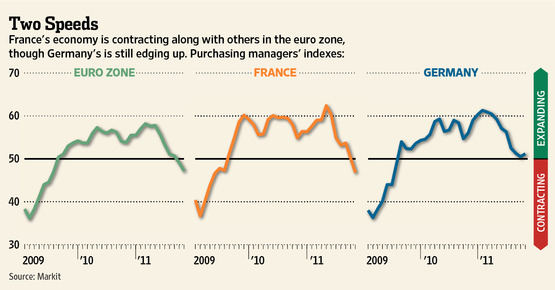 The level of lending interdependence between the various countries is illustrated in the above graphic. In total, Greece, Italy, Ireland, Portugal and Spain owe British banks $388 billion, German banks $704 billion, and French banks $911 billion. As we have noted, the primary problem in Europe is too much debt and too little economic growth. The contraction in GDP in the periphery countries of Greece, Ireland, Spain and Portugal is now affecting the three largest economies– Italy, France, and Germany, which is Europe’s linchpin. Germany derives 70% of its export volume from other countries in the E.U., so it will not be immune to the slowdown spreading throughout Europe. In September, factory orders in Germany plunged 4.3%, with orders from the Euro-zone plummeting 12%. In October, France’s Purchasing Managers Index dropped to 45.6, its lowest level since April 2009. An indication of how broad the weakness is in the Euro-zone can be seen in the latest Markit Euro-zone composite Purchasing Manager’s Index. It fell to 46.5, the lowest since November 2008 at the height of the financial crisis. Markit’s Services Index lost 2.4 points in October to 46.4, the lowest since July 2009.
The level of lending interdependence between the various countries is illustrated in the above graphic. In total, Greece, Italy, Ireland, Portugal and Spain owe British banks $388 billion, German banks $704 billion, and French banks $911 billion. As we have noted, the primary problem in Europe is too much debt and too little economic growth. The contraction in GDP in the periphery countries of Greece, Ireland, Spain and Portugal is now affecting the three largest economies– Italy, France, and Germany, which is Europe’s linchpin. Germany derives 70% of its export volume from other countries in the E.U., so it will not be immune to the slowdown spreading throughout Europe. In September, factory orders in Germany plunged 4.3%, with orders from the Euro-zone plummeting 12%. In October, France’s Purchasing Managers Index dropped to 45.6, its lowest level since April 2009. An indication of how broad the weakness is in the Euro-zone can be seen in the latest Markit Euro-zone composite Purchasing Manager’s Index. It fell to 46.5, the lowest since November 2008 at the height of the financial crisis. Markit’s Services Index lost 2.4 points in October to 46.4, the lowest since July 2009.
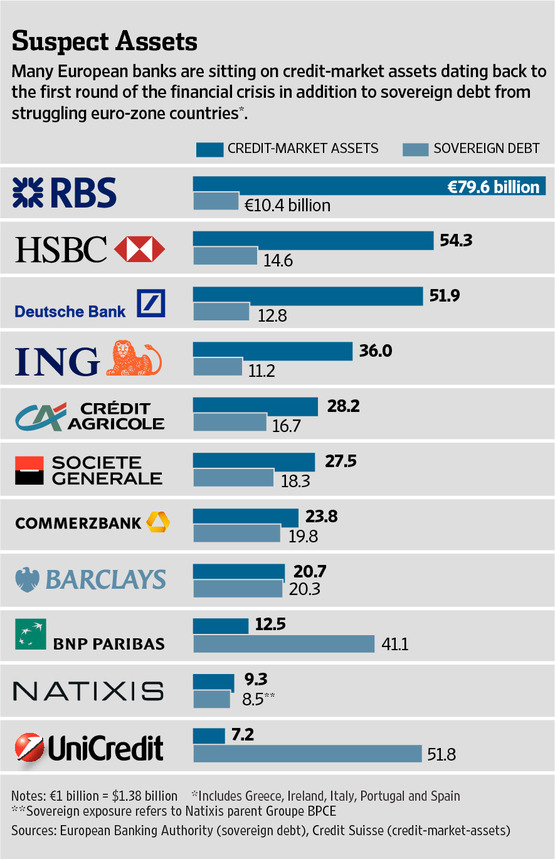 As growth remains weak, or worse a recession develops, the weakest economies in Europe will be unable to lower their budget deficits. The debt to GDP ratios for Greece, Ireland, Belgium, Portugal, Spain, and Italy will increase, and lead to more austerity measures. Austerity equals less growth. As this unfolds, the value of the sovereign debt of these countries will likely fall further, causing interest rates to rise. The higher cost of money will weaken their economies, and increase respective budget deficits. Sounds like a classic vicious cycle of weakness begetting more weakness. If the ECB does intervene and buys the sovereign debt of these countries, it will not be enough to restore sustainable economic growth. Stock markets around the globe would rally smartly, but absent sustainable growth, intervention will only buy time, and time alone will not reduce debt loads or generate GDP growth. The Federal Reserve has engaged in two rounds of Quantitative Easing and the U.S. does not have a self sustaining recovery in place.
As growth remains weak, or worse a recession develops, the weakest economies in Europe will be unable to lower their budget deficits. The debt to GDP ratios for Greece, Ireland, Belgium, Portugal, Spain, and Italy will increase, and lead to more austerity measures. Austerity equals less growth. As this unfolds, the value of the sovereign debt of these countries will likely fall further, causing interest rates to rise. The higher cost of money will weaken their economies, and increase respective budget deficits. Sounds like a classic vicious cycle of weakness begetting more weakness. If the ECB does intervene and buys the sovereign debt of these countries, it will not be enough to restore sustainable economic growth. Stock markets around the globe would rally smartly, but absent sustainable growth, intervention will only buy time, and time alone will not reduce debt loads or generate GDP growth. The Federal Reserve has engaged in two rounds of Quantitative Easing and the U.S. does not have a self sustaining recovery in place.
After the financial crisis in 2008, U.S. banks were aggressive in moving shaky sub-prime loans and C.D.O.’s on U.S. residential real estate off their balance sheets. Since 2007, Bank of America, Citigroup and JP Morgan have off loaded over 80% of the troubled assets, according to an analysis by Credit Suisse. It may be hard to believe, but European banks are still holding way too much of these suspect assets. (Chart pg. 3) According to research by JP Morgan, the four largest banks in France still have 70% of the real estate related loans they had in 2007. Needless to say, these holdings have not fared well, as U.S. residential and commercial real estate values continue to fall.
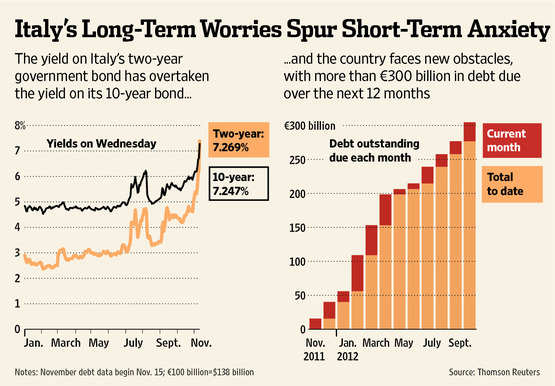 As we noted last month, European banks have experienced increasing difficulty in rolling over existing debt, as U.S. money market funds have significantly reduced their exposure to banks in Europe, and banks in Europe curtailed lending to each other. The European Central Bank has addressed this problem by expanding its lending to more than $650 billion to banks in Ireland, Greece, Italy, Spain, Portugal, and France. We have no doubt that the ECB’s funding has increased in recent weeks, as liquidity continues to dry up. This was a big problem in 2008 for U.S. banks that depended on access to short term funding, once sources for short term liquidity dried up. BNP Paribas and Societe Generale are especially vulnerable, since more than 70% of their funding matures within one year. As investors assess all the risks facing Europe’s banks, and French banks in particular, these two banks may find it nearly impossible to maintain their funding levels. The vulnerability of French banks has not been lost on global investors, as they have begun shunning French government bonds. The spread between French and German 10-year yields has widened to 1.71%, the widest since the early 1990’s.
As we noted last month, European banks have experienced increasing difficulty in rolling over existing debt, as U.S. money market funds have significantly reduced their exposure to banks in Europe, and banks in Europe curtailed lending to each other. The European Central Bank has addressed this problem by expanding its lending to more than $650 billion to banks in Ireland, Greece, Italy, Spain, Portugal, and France. We have no doubt that the ECB’s funding has increased in recent weeks, as liquidity continues to dry up. This was a big problem in 2008 for U.S. banks that depended on access to short term funding, once sources for short term liquidity dried up. BNP Paribas and Societe Generale are especially vulnerable, since more than 70% of their funding matures within one year. As investors assess all the risks facing Europe’s banks, and French banks in particular, these two banks may find it nearly impossible to maintain their funding levels. The vulnerability of French banks has not been lost on global investors, as they have begun shunning French government bonds. The spread between French and German 10-year yields has widened to 1.71%, the widest since the early 1990’s.
As we have discussed previously, Italy should be Europe’s poster child for having too much debt and too little growth. Over the last 10 years, the world’s eighth largest economy, and third largest in the E.U., has grown a scant .28% annually, while amassing a debt to GDP ratio of 120%. Italy’s debt load of $2.6 trillion is the fourth largest in the world. With annual debt service of $110 billion, annual debt service was a manageable 5% of GDP. Italy’s average cost of funds was 4.2%, until recently. In recent days, the Italian bond market has plunged, causing 5 year yields to soar from 2.3% at the end of 2010 to 6.3%, with 10 year yields topping 7.2%. In 2012, Italy must roll $420 billion (E300 billion) of its debt, roughly 16% of its outstanding debt. If Italy’s average cost of funds rises above 6% over time, it will be extremely difficult to grow its economy, and its debt to GDP ratio could also rise to Greece like levels in coming years.
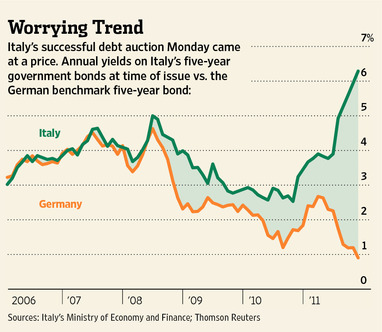 The large decline in Italian bond prices represents another hit to the asset base of European banks holding large positions. It is also having an adverse affect on European insurance companies who hold $408 billion of Italian sovereign debt, or 75% of their $612 billion is shareholder equity, according to JP Morgan.
The large decline in Italian bond prices represents another hit to the asset base of European banks holding large positions. It is also having an adverse affect on European insurance companies who hold $408 billion of Italian sovereign debt, or 75% of their $612 billion is shareholder equity, according to JP Morgan.
The collateral damage from the slowdown in Europe is having a negative impact on most of the small eastern European countries like the Czech Republic, Poland and Hungary, who derive more than half of their export volumes from other countries in the Euro-zone. The recession that is likely to grip most of the countries in the European Union will cause youth unemployment rates to rise and sow discontent among workers both young and old. As austerity measures are implemented and pensions reduced, divisiveness between countries will grow and become problematic.
All For One, One For All
When the Euro was launched in January 1999, it was hoped that the European Union would one day be the largest economy in the world. In 2010, according to IMF data, total GDP in the E.U. reached $16.2 trillion, compared to $14.9 trillion in the U.S., and $5.9 trillion in China. The European sovereign debt crisis has exposed numerous fissures within the ‘Union’. 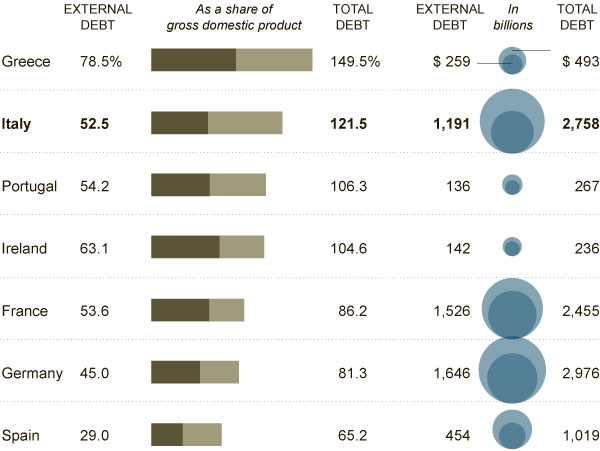 Although European leaders have stated the European Union will remain intact, we continue to have our doubts. The obvious candidates to leave the Union are Greece and Ireland, as the austerity measures being imposed on each country causes a public backlash that leads them to bolt. However, Germany is the key. As the crisis intensifies in coming weeks and months, pressure on the ECB to launch its version of quantitative easing will mount from within the European Union and from the United States. We have no doubt that Treasury Secretary Geitner has been lecturing the ECB for months on the need to intervene. Germany has so far resisted this advice.
Although European leaders have stated the European Union will remain intact, we continue to have our doubts. The obvious candidates to leave the Union are Greece and Ireland, as the austerity measures being imposed on each country causes a public backlash that leads them to bolt. However, Germany is the key. As the crisis intensifies in coming weeks and months, pressure on the ECB to launch its version of quantitative easing will mount from within the European Union and from the United States. We have no doubt that Treasury Secretary Geitner has been lecturing the ECB for months on the need to intervene. Germany has so far resisted this advice.
At some point Germany will be forced to make a choice if the situation unravels. Their choice will depend on whether they believe intervention by the ECB will ultimately succeed, and the cost to Germany to back stop the ECB. If Germany does not believe ECB quantitative easing will contain the crisis, they may surprise everyone and choose to not allow the ECB to expand its balance sheet. As the strongest country in the E.U., it would be in Germany’s best interest to let the weakest members fall apart, while using its resources to fortify its banks. This strategy would allow Germany to weather the crisis and emerge faster and stronger than any other country within the European Union. This may seem like a form of economic warfare because it is. As the European banking system implodes, the ‘All for one, one for all’ spirit on which the E.U. was launched will disintegrate into every country for itself.
Emerging Markets, China, Brazil, and India
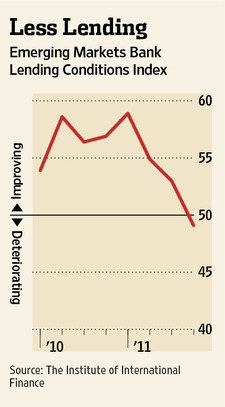 The Institute of International Finance surveys senior loan officers in 63 emerging market banks to gauge their lending conditions, and is modeled on the quarterly lending surveys by the Federal Reserve and European Central Bank. The most recent survey conducted in late September found that banks in Asia, Eastern Europe, and Latin America are tightening credit standards and facing an increase in bad loans. The report found that funding conditions have “deteriorated significantly”. Of all the banks surveyed, 69% said funding conditions tightened during the third quarter, while just 2% said they eased. The banks most affected were found in Eastern European countries. This isn’t a surprise, given their dependence on the major banks of Europe.
The Institute of International Finance surveys senior loan officers in 63 emerging market banks to gauge their lending conditions, and is modeled on the quarterly lending surveys by the Federal Reserve and European Central Bank. The most recent survey conducted in late September found that banks in Asia, Eastern Europe, and Latin America are tightening credit standards and facing an increase in bad loans. The report found that funding conditions have “deteriorated significantly”. Of all the banks surveyed, 69% said funding conditions tightened during the third quarter, while just 2% said they eased. The banks most affected were found in Eastern European countries. This isn’t a surprise, given their dependence on the major banks of Europe.
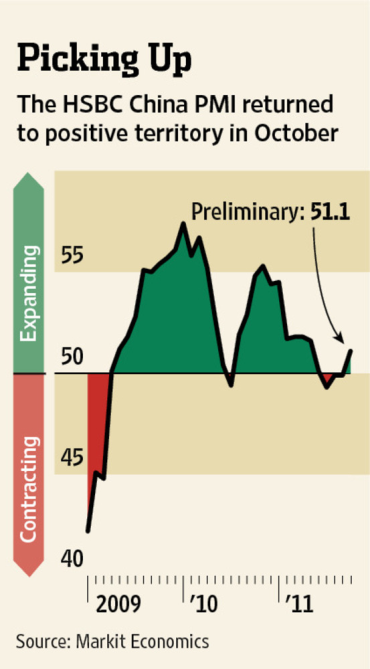 Coming into 2011, we felt the tightening of monetary policy by Brazil, China, and India would continue, and lead to a second half slowing in these high growth economies. In the first half of this year, all three countries tightened monetary policy further, and there are signs that these economies have begun to slow.
Coming into 2011, we felt the tightening of monetary policy by Brazil, China, and India would continue, and lead to a second half slowing in these high growth economies. In the first half of this year, all three countries tightened monetary policy further, and there are signs that these economies have begun to slow.
Industrial output was up 13.2% in October in China from a year ago, but it’s the slowest annual rise in a year. The HSBC China Purchasing Managers Index rose to 51.1 in October, but is well down from the highs of 2009 and 2010. As we have discussed previously, Chinese state-owned banks loaned $3 trillion to stimulate growth in the wake of the financial crisis in 2008 in the last two years. This amounts to more than 50% of China’s $5.9 trillion of GDP. It is unlikely that bankers in China will prove any smarter than their U.S. or European counterparts. This run away lending boosted land values, real estate values, and no doubt expanded China’s export capacity. Europe is China’s largest export customer, so demand from Europe will be weaker as Europe slips into a recession. Exports from Guangdong province, which accounts for a quarter of China’s export trade, have dropped like a stone. In October, Guangdong’s overall exports fell 8.7%, versus a gain of 26% in the first half of 2011. If the U.S. slows as we expect, Chinese companies dependent on exports will be saddled with a glut of export capacity. This will result in a surge in bad loans for China’s state owned banks. And there are signs that the real estate bubble in China is beginning to deflate, which will only create more bad loans. Sometime in 2012, we will be reading stories about banking problems in China.
Taiwanese manufacturing activity fell at its fastest rate in almost three years in October, according to its Purchasing Manufacturer’s Index, while South Korean output continued to shrink as well.
In Brazil, industrial production fell 2% in September compared to August. Output in 16 of 27 sectors contracted, led by a 9% decline in automobile production and other durable goods, and a 5.5% drop in factory machines. This prompted Brazil’s central bank to lower rates for a second time since August 31 from 12.5% to 11.5% to “mitigate the effects” of a slowing global economy.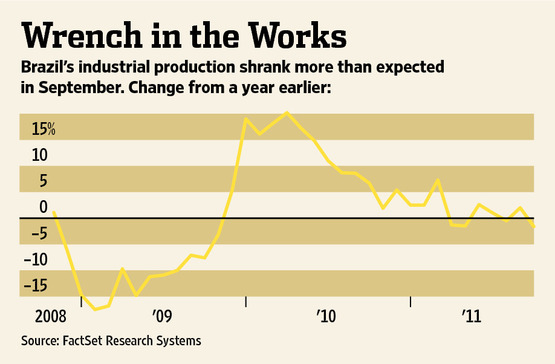
The Reserve Bank of India raised its benchmark rate to 8.5% on October 25, its 13th increase in 19 months to dampen inflationary pressures, which has been hovering near 10% for months. The cumulative impact from higher rates and the global slowdown will cause India’s economy to slow in coming months. The central bank expects GDP growth to slow to 7.6% in the year beginning in March, from 8.5% last year. That’s probably optimistic.
Will the U.S Decouple from Europe?
In late 2007, many economists and investment strategists expected the global economy would not be affected by a slowdown in the U.S. Since few were expecting a recession to develop in the U.S., the forecast was that Europe and Asia would decouple from the U.S. and continue to enjoy reasonable growth. We didn’t agree with that assessment, and in our March 2008 letter stated “The combination of weaker credit creation and slower velocity spells R-E-C-E-S-S-I-O-N.” 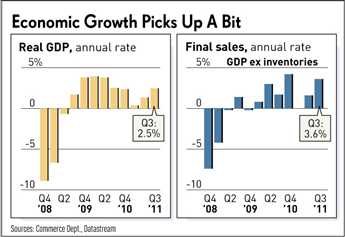 Over the past month, there have been a number of economic reports that reflect a modest improvement in the U.S. economy. The first estimate of third quarter GDP suggested the economy grew 2.5%. As discussed in the October letter, we expected business investment to pick up as businesses took advantage of the investment tax credit which expires on December 31, 2011. Business investment represented 1.7% of the 2.5% increase in GDP. Unless the tax credit is extended, we expect business investment to taper off in the first part of 2012, since the tax credit pulled business investment demand from 2012 into the last half of 2011.
Over the past month, there have been a number of economic reports that reflect a modest improvement in the U.S. economy. The first estimate of third quarter GDP suggested the economy grew 2.5%. As discussed in the October letter, we expected business investment to pick up as businesses took advantage of the investment tax credit which expires on December 31, 2011. Business investment represented 1.7% of the 2.5% increase in GDP. Unless the tax credit is extended, we expect business investment to taper off in the first part of 2012, since the tax credit pulled business investment demand from 2012 into the last half of 2011.
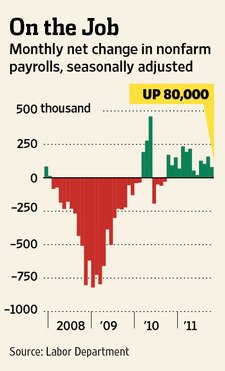 Although only 80,000 jobs were created in October, investors were heartened it wasn’t weaker, and to boot, the September report was revised up to 191,000 from 137,000. However, hours worked were unchanged at 34.3, and average hourly earnings grew only 1.8%, far less than the 3.6% increase in the cost of living from last year. The disposable income of most workers is being squeezed by the lack of income growth and the higher cost of living, which will keep a lid on consumer spending in coming months. In the first 10 months of 2011, job growth has averaged 120,000, just above the 110,000 needed each month to absorb new entrants into the labor market. Since the recession ended in June 2009, the economy has regained just 2.3 million of the 8.8 million jobs lost, and the unemployment rate has held at 9% or higher for nine consecutive months. Even at the better pace of hiring, it will take years before all the lost jobs are recovered. Better, but hardly anything to get too excited about.
Although only 80,000 jobs were created in October, investors were heartened it wasn’t weaker, and to boot, the September report was revised up to 191,000 from 137,000. However, hours worked were unchanged at 34.3, and average hourly earnings grew only 1.8%, far less than the 3.6% increase in the cost of living from last year. The disposable income of most workers is being squeezed by the lack of income growth and the higher cost of living, which will keep a lid on consumer spending in coming months. In the first 10 months of 2011, job growth has averaged 120,000, just above the 110,000 needed each month to absorb new entrants into the labor market. Since the recession ended in June 2009, the economy has regained just 2.3 million of the 8.8 million jobs lost, and the unemployment rate has held at 9% or higher for nine consecutive months. Even at the better pace of hiring, it will take years before all the lost jobs are recovered. Better, but hardly anything to get too excited about.
These reports have enabled most economists and strategists to stop worrying about a double dip in the U.S. Complacency about the U.S. economy’s prospects going into 2012 has replaced the palpable fear of another recession most felt just three months ago. The table is now set for most investors to be surprised when the economy slows in the first half of 2012, renewing concerns about a double dip in the process. According to Standard & Poors, 46% of the sales for the 500 companies in the S&P come from outside the U.S., with 14% coming from Europe. Growth, however, isn’t just slowing in Europe, but also in Brazil, China and India, which were previously very strong. The 54% of S&P sales in the U.S. will also be impacted if growth slows as we expect. And for those who think U.S. banks will either benefit or be able to sidestep Europe’s banking crisis, consider this statistic. A recent Congressional Research Service report estimated that American bank exposure to German and French banks totaled more than $1.2 trillion. While our banks may be in better shape than their European counterparts, they are hardly a picture of health. Finally, world GDP in 2010 was 63 trillion, according to the International Monetary Fund. Of that total, the E.U., United States, China, Japan, Britain, Brazil, and India comprise more than 70% of world GDP, with the E.U. and the U.S. contributing almost 50%. Growth in every one of these countries is slowing, and much of the E.U. will be in a recession in 2012. The notion that the U.S. will be able to decouple from the global slowdown that will intensify in 2012 is pure fantasy.
Congressional Smoke, Mirrors, and Government Statistics
We have no idea whether the Congressional Super Committee will come up with a plan to reduce the deficit by $1.2 trillion or more, before the November 23 deadline. Even if they do patch together a deal, it will be a total sham, because it will be based on the wildly optimistic assumptions by the Congressional Budget Office. The CBO is the non-partisan entity that provides baseline projections for GDP growth and tax revenue, and will ‘score’ the impact of any Super Committee deficit reduction plan. According to the CBO, the U.S. economy will average 3% annual growth between 2012 and 2021. You will also be heartened to know, there will be no recessions during this period either.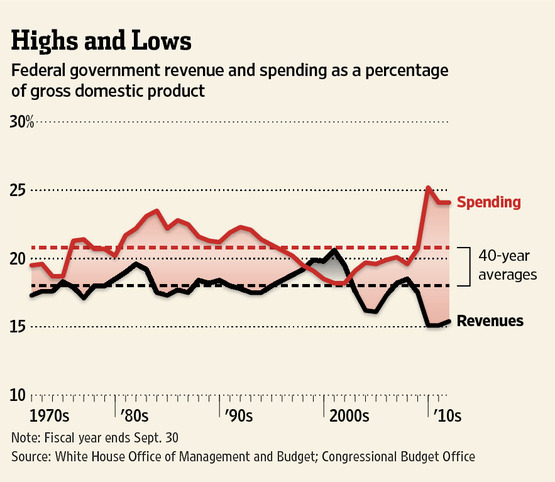 Obviously, no one at the CBO has bothered to read “This Time is Different”, by economists Carmen Reinhart and Kenneth Rogoff. Their research shows that after a country’s debt to GDP ratio exceeds 90% of GDP in the wake of a financial crisis, economic growth is 1% to 1.5% less in the ensuing decade than in the decade prior to the crisis. Since 1990, U.S. GDP growth has averaged 2.6%, and in the decade since 2000 just 1.6%. Since we like being optimistic, we’ll use the 20 year average of 2.6%, and only lower growth by 1%. This suggests that GDP growth would be lucky to average 2% annually, let alone 3% through 2021. The amount of tax revenue the CBO is estimating based on 3% annual growth will not be realized, if the U.S. grows more slowly. Furthermore, slower growth will keep government spending elevated, as politicians avoid cutbacks that would increase the burdens on the poor and elderly. The Super Committee will base their deficit reduction plan on revenue assumptions that are unrealistic, and spending cuts that probably won’t materialize in the real world. Although the stock market may rally on news of a deal, the reality of what has not been accomplished will eventually provide a rude wake up call, as the deficit in coming years remains far larger than CBO projections.
Obviously, no one at the CBO has bothered to read “This Time is Different”, by economists Carmen Reinhart and Kenneth Rogoff. Their research shows that after a country’s debt to GDP ratio exceeds 90% of GDP in the wake of a financial crisis, economic growth is 1% to 1.5% less in the ensuing decade than in the decade prior to the crisis. Since 1990, U.S. GDP growth has averaged 2.6%, and in the decade since 2000 just 1.6%. Since we like being optimistic, we’ll use the 20 year average of 2.6%, and only lower growth by 1%. This suggests that GDP growth would be lucky to average 2% annually, let alone 3% through 2021. The amount of tax revenue the CBO is estimating based on 3% annual growth will not be realized, if the U.S. grows more slowly. Furthermore, slower growth will keep government spending elevated, as politicians avoid cutbacks that would increase the burdens on the poor and elderly. The Super Committee will base their deficit reduction plan on revenue assumptions that are unrealistic, and spending cuts that probably won’t materialize in the real world. Although the stock market may rally on news of a deal, the reality of what has not been accomplished will eventually provide a rude wake up call, as the deficit in coming years remains far larger than CBO projections.
Tax revenue as a percent of GDP is the lowest since 1950, and spending is near its highest level. The gap between spending and tax revenue will be difficult to close, take a long time, and impose hardships that will be difficult to bear for millions of Americans. If our motivation to persevere flags in coming years, all we will need to do is look at Greece and Italy for a glimpse of what the future may hold for US.
Stocks
As the stock market approached its low on October 4, sentiment was lopsidedly negative. The spread between the percent of bulls and bears in the weekly Investors Intelligence survey showed 11.9% more bears than bulls, and the American Association of Individual Investors registered a plurality of 22.7% more bears. The rally in the stock market and modest improvement in the economy have caused sentiment to shift dramatically. In the most recent Investors Intelligence survey there were 14.8% more bulls, while the AAII report last week showed bulls outnumbered bears by 20.1%. Technically, the rally has been on low volume, as the 5 day average of total volume has dropped 34% since the October 4 low, and the 21 day average is off by 23%. This suggests the rally was been more supported by a decline in selling pressure, rather than a high level of buying conviction. The market has also sold off sharply on higher volume, whenever there has been a piece of bad news that increased selling. This is not a good sign, especially since we believe there is more bad news to come.
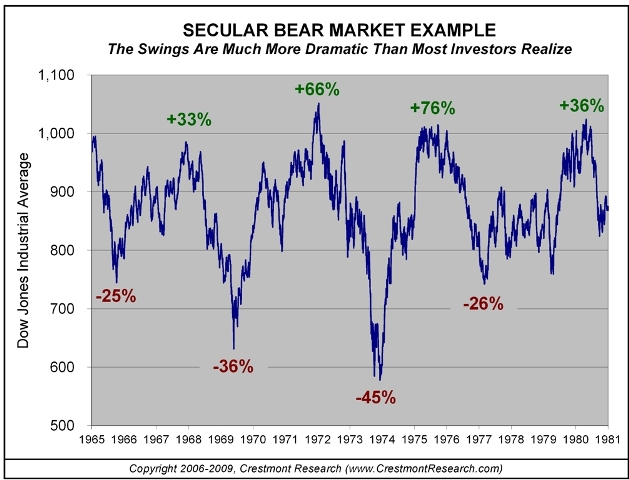 As we discussed in the October 21 letter, “The S&P may eventually approach 1300-1320 by mid December, since sentiment is still fairly cautious, which is supportive. If you didn’t do any selling when the S&P broke below 1258 on August 2, we would suggest selling into strength if the S&P trades between 1230 and 1270. It is possible that this rally will end as quickly as it began, if Europe doesn’t get it together, and worries about the U.S. economy resurface sooner rather than later.” The high for the rally was registered on October 27 when the S&P reached 1292.66, after Europe announced its most recent plan to contain the sovereign debt crisis. In our Special Update on October 30, we recommended selling into strength since the upside was limited. Since then, the S&P has made secondary peaks on November 8 at 1277.55, and 1266.98 on November 11. Seasonality is normally supportive during this time of year, so another rally attempt is certainly possible. But these are not normal times.
As we discussed in the October 21 letter, “The S&P may eventually approach 1300-1320 by mid December, since sentiment is still fairly cautious, which is supportive. If you didn’t do any selling when the S&P broke below 1258 on August 2, we would suggest selling into strength if the S&P trades between 1230 and 1270. It is possible that this rally will end as quickly as it began, if Europe doesn’t get it together, and worries about the U.S. economy resurface sooner rather than later.” The high for the rally was registered on October 27 when the S&P reached 1292.66, after Europe announced its most recent plan to contain the sovereign debt crisis. In our Special Update on October 30, we recommended selling into strength since the upside was limited. Since then, the S&P has made secondary peaks on November 8 at 1277.55, and 1266.98 on November 11. Seasonality is normally supportive during this time of year, so another rally attempt is certainly possible. But these are not normal times.
We believe the U.S. stock market is in a secular bear market that could last until 2014-2016, and could prove similar to the secular bear market that held the DJIA in a broad trading range during 1965-1982. This secular bear market could extend until 2020 or longer, since it is associated with the largest financial crisis in history that is global in its nature. The fiscal and monetary challenges we’re facing are unprecedented, and may require more time to work through than the 17 years of the 1965-1982 experience.
Our investment model suggests the cyclical bull market from March 2009 has ended, and a new bear market has begun. If this macro analysis is correct, one or more declines of 25% to 35% will occur during the next five years, before the current secular bear market ends. Given the European banking crisis and the fragility of the recovery in the U.S., it is not hard to see the S&P 500 falling to 1040 or 950 in 2012. In addition, to lowering exposure to the stock market, investors should consider allocating a small portion of their portfolio to the Prudent Bear fund or the inverse S&P 500 ETF SH. Both would rise in value as the market declines.
Bonds
As long as the 10-year Treasury yield holds below 2.45%, we view it as a warning sign of further banking problems in Europe, and coming economic weakness in the U.S. Since hitting a low of 1.70% on September 23, the high has been 2.41% on October 27, when Europe’s plan was announced. Investors should buy TLT, which is the ETF that mirrors the yield on the 20-year Treasury bond. It traded as high as $125.03 on October 4, just as the stock market was making its low. We think it will trade above $125.03. Add to the position if it drops below $115.00. There is a gap at $112.85 that may be filled, before the move to a new high begins.
Dollar
In our May letter we recommended going long the Dollar via its ETF (UUP) at $21.56, and in our July 31 Special Update, we suggested adding to the UUP position below $20.91. A close above $22.62 should constitute a breakout, and set the stage for a rally above $24.00 in coming months.
Gold
We would recommend buying the gold ETF GLD if it falls below $154.00, using $140.00 as a stop.
Macro Tides


